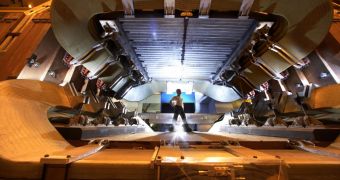Investigators working at a particle detector based at the Large Hadron Collider (LHC) have recently published the conclusions of two new studies, which analyzes two different types of decay for a series of particles called “strange B” mesons.
The data the team used for the researches were collected during collision experiments carried out at the LHC in 2010. The facility is the largest and most powerful particle accelerator in the world, and it's capable of producing an energy level of 7 teraelectronvolts (TeV) per beam (14 TeV combined).
Analyzing the decay of such particles is a critical step towards understanding why we exist at all. The most finely-tuned theories explaining how the Universe formed after the Big Bang theoretically imply that we shouldn't be here.
In the first moments after the Cosmos expanded into being, equals amounts of matter and antimatter were produced. These quantities should have annihilated each other entirely, but that obviously didn't happen. Experts are now trying to figure out what stopped this annihilation.
Studying rare particle decays is a good place to start, explains Syracuse University physicist Sheldon Stone, the leader of the LHCb detector science team. The LHCb is one of the six scientific experiments on the 27-kilometer particle accelerator.
Studying the properties of matter and antimatter directly is a very challenging task, but strange B mesons are among the very few particles that can enable such investigations. Particles known as B-bars, the antimatter partners of strange B mesons, can be used for this task as well.
What investigators sought to uncover in the new studies were the differences that exist between the decay properties of strange B mesons and B-bars. Learning this could lead to a better understanding of the current composition of the Universe.
In two papers the researchers published in the March 28 issue of the esteemed journal Physics Letters B, they explain that the observable Cosmos has large amounts of matter, but no discernible antimatter.
“We know when the universe formed from the Big Bang, it had just as much matter as antimatter, but we live in a world predominantly made of matter,” Stone explains.
“Therefore, there had to be different properties in the decaying of both in order to end up with a surplus of matter,” he says about the two types of particles his team focused its research on.
“We want to figure out the nature of the forces that influence the decay of these [B meson] particles. These forces exist, but we just don't know what they are. It could help explain why antimatter decays differently than matter,” the expert goes on to say.
Thus far, the LHCb team has made tremendous progress. A total of 750 scientists from 15 countries are handling this detector, which is partially funded by the US National Science Foundation (NSF).

 14 DAY TRIAL //
14 DAY TRIAL //